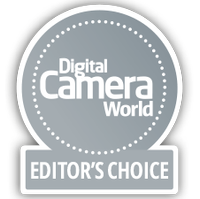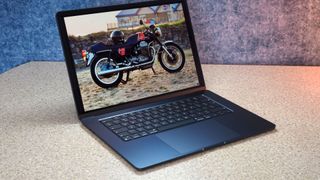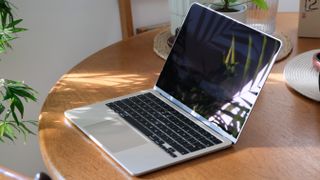The best MacBooks for photo editing in 2024: options to suit every budget
These are the best MacBooks for photo editing, from affordable classics to the latest performance powerhouses

Buying one of the best MacBooks for photo editing could be a great way to upgrade your workflow. These Apple laptops are well-known for their powerful components, making photo editing fast and responsive.
MacBooks also tend to be fairly lightweight and slim, which makes them a great option for photographers who need to edit their images on the go. Plus, the macOS operating system is efficient at running both the best photo editing software and the best video editing software.
You'll get great battery life, too, which means that you can spend an entire day editing images without having to stop to find a power supply. And finally, every MacBook here will be able to run macOS Sequoia and its Apple Intelligence technology, which boosts image editing, photo search and more.

Ben is the Imaging Labs manager, responsible for all the testing on Digital Camera World and across the entire photography portfolio at Future. But he is also our in-house computing guru – and is the person who has used and benchmarked hundreds of different laptops over the years we have featured on the website.
The Quick List

This is far and away the best MacBook for photo editing. The M4 chip handles photo editing applications like Photoshop with ease, and the display is stunning.
Read more below

Last year's MacBook Pro model is more affordable than the latest, but still very powerful. Our reviewers found it could handle photo editing tasks with ease.
Read more below

If you're looking for a laptop that's lightweight and affordable, but still more than powerful enough for video editing, this MacBook Air is well worth a look.
Read more below

Supremely light and compact, this super-thin laptop can still be specced with enough RAM and storage for photo editing.
Read more below

This might be the most affordable Apple MacBook you’ll find, but neither its design nor its performance will disappoint you.
Read more below
Best MacBooks for photo editing in 2024
Why you can trust Digital Camera World
Best MacBook overall


1. MacBook Pro (M4, 2024)
Specifications
Reasons to buy
Reasons to avoid
The MacBook M4 Pro is far and away the best MacBook for photo editing today. Performance-wise, the M4 chip handles photo editing applications like Photoshop and Lightroom with ease, and the standard 16GB of unified memory provides smooth performance for working with large image files. The SD card slot is particularly convenient for photographers, allowing direct transfer of images from cameras. And the long battery life of up to 18.5 hours means you can edit on location without constantly searching for power outlets.
Combined with its portable design at just 3.4 pounds, the MacBook M4 Pro offers professional-grade photo editing capabilities in a mobile package that's both powerful and practical.
The optional nano-texture display coating is particularly transformative for photo editors, as it effectively eliminates reflections and glare while maintaining color accuracy with a Delta-E score of 0.19 (where 0 is perfect). This makes it easier to edit photos in any lighting condition, whether indoors or outdoors.
More broadly, the 14.2-inch Liquid Retina XDR display offers impressive specifications with up to 1,000 nits brightness for SDR content and 1,600 nits peak for HDR content, along with P3 wide color gamut support and ProMotion's 120Hz refresh rate. The screen's nearly 4K resolution (3096 x 1964 pixels) and mini-LED technology delivering a 1,000,000:1 contrast ratio ensure exceptional detail and color reproduction crucial for photo editing.
Best MacBook for value

Specifications
Reasons to buy
Reasons to avoid
The MacBook Pro 14 M3 has a lot to offer photo editors, particularly with its stunning Liquid Retina XDR display that offers exceptional color accuracy and contrast. The reintroduction of the SD card slot is a game-changer for photographers, eliminating the need for dongles during image transfers. The M3 chip handles photo editing tasks with impressive speed, showing particular strength when working with apps like Lightroom and Photoshop.
For photo editors coming from Intel-based MacBooks, the performance leap is substantial, with significantly faster export times and smoother handling of large image files. The laptop maintains its performance while staying cool and quiet, even during intensive editing sessions. However, the base 8GB RAM configuration might be limiting for serious photo editors working with multiple applications simultaneously, making the 16GB upgrade almost essential for professional work.
The 14.2-inch display's high brightness and contrast make it ideal for detailed photo editing work, while the improved speaker system provides excellent audio quality for multimedia work. Combined with its portable design and robust build quality, it's an excellent choice for photographers who need powerful editing capabilities on the go, though careful consideration should be given to RAM configuration when purchasing.
For more details, read our Apple MacBook Pro 14 (M3, 2023) review.
Best lightweight MacBook

Specifications
Reasons to buy
Reasons to avoid
If you're for a MacBook that's light on the wallet, and also physically light, the MacBook Air 15 is our top recommendation. It’s a safe bet for any photographer, videographer or creative who wants a larger screen and a processor capable of running the latest editing software with ease – all in a laptop so light you can add it to your backpack and credibly not notice much difference.
The MacBook Air features quality components, with a standout display that provides dazzling color. If you expect to mostly do light editing, the 16GB of RAM in the base model will certainly be sufficient. Note, though, that until recently the base model only came with 8GB so check the details first if you're buying from a third-party retailer.
You’ll also want to upgrade the miserly 256GB storage, or live with relying on external storage. The other main limitation is the lack of connection ports, with only two USB-C ports provided. You’ll need adaptors for SC Cards or connecting to most external monitors.
Read more: MacBook Air 15.3-inch M3 (2024) review
Best small MacBook for photo editing

Specifications
Reasons to buy
Reasons to avoid
Do you prize portability over a big screen? Then this is the MacBook for you. Compact, light and very thin, making it supremely portable. And it's powerful too: The base M3 chip packs an 8‑core CPU and 8‑core GPU, which can be upgraded to a 10-core GPU for an additional cost. The performance is surprisingly potent for such a lightweight machine, and it’s particularly impressive that this fanless design manages to stay fairly cool while you edit.
The 8GB RAM and 256GB of solid-state storage offered as standard is fine for anyone using a laptop mainly for writing, browsing and YouTube, but busy photographers will benefit from upgrading to 16GB of RAM and at least 512GB of storage. You only get two USB-C ports – no SD Card, no HDMI – but wireless connectivity is first-rate.
Read more: MacBook Air M3 (2024) full review
Best MacBook on a budget

Specifications
Reasons to buy
Reasons to avoid
The MacBook Air M1 isn’t part of the official Apple range any longer, but it’s still available at retailers, and is well worth considering if you're on a tighter budget. The MacBook Air range is ideal for lighter use, which means owning the latest processor isn't critical, and the M1 in this machine is more than up to the job for everyday tasks, including image-editing. That’s makes this option terrific value for money.
In other respects, this laptop echoes the pros and cons that the MacBook Air continues to offer today, a sign that Apple has given much thought to who is likely to buy this type of laptop and what they most value. The display is superb, even by today’s standards, with strong contrast and a wide color range. Photos look great. The keyboard is a pleasure to use, and the trackpad is generously sized.
Connectivity is weighted towards wireless networking, with only two USB-C ports and a headphone socket to handle physical connections – and the power charger uses one of those USB-C ports. 8GB of RAM is tolerable for the sort of lighter work you’ll complete on the MacBook Air, but do upgrade from 256GB of storage if you’re offered the option.
Read more: Apple MacBook Air 13-inch M1 review
How to choose the best MacBook for photo editing
When you're looking for the best MacBook for photo editing, there isn't necessarily a one-size-fits-all solution. Aspects such as power, portability, affordability and more can all weigh on a user's decision. However, these are the key things you should be considering in your search.
What processor should I choose?
Older MacBooks used to use Intel processors, but these days Apple's own M-series system-on-chip processors rule the roost. The latest M3 and M4 offerings are incredibly fast while also being incredibly power-efficient. The preceding M2 and M1 chips were also highly regarded when released though, so don't rule out an M1- or M2-based MacBook if the price is right.
How much RAM (memory) do I need?
The amount of RAM you decide to invest in is hugely important. We would recommend a minimum of 16GB, as this will help your MacBook load applications more quickly (and keep more open at the same time). You might initially think that 16GB of RAM is overkill for your needs, but it's important to remember that you can't upgrade a MacBook's RAM further down the line – so plan ahead for the future!
How much storage should I spec?
Storage space is definitely something important to consider. Unfortunately, while you can replace the hard drive of most Windows laptops, it's impossible to do this with a MacBook. While you can certainly add the best portable hard drive or best portable SSD to the mix, we'd recommend starting off with a minimum of 500GB of internal storage to give you plenty of space to play with.
What screen size is best?
Don't forget to consider the screen that you want. The larger screen you have, the easier it will be to see and inspect the photo you're working on (although, keep in mind that the larger a laptop is, the harder it will be to lug around). For the last few years MacBooks have featured high resolution 'Retina' displays, which are fantastic for seeing your images in all of their stunning detail.
How we test the best MacBooks for photo editing
When reviewing a laptop, we assess its internal hardware features, build quality, ergonomics, performance in a variety of usage scenarios, value for money, and its overall suitability for its target buyer. Although we'll evaluate a laptop with a typical user in mind, we will also pay particular attention to the perspective of photo and video enthusiasts, with special focus given to screen quality and color space coverage. Where possible, a monitor calibrator will be used to measure a laptop's display performance to assess whether it matches a manufacturer's claims, and software benchmarks like GeekBench are used to measure a laptop's processor and graphics card capabilities.
Find out more about how we test and review on Digital Camera World
Get the Digital Camera World Newsletter
The best camera deals, reviews, product advice, and unmissable photography news, direct to your inbox!
Ben is the Imaging Labs manager, responsible for all the testing on Digital Camera World and across the entire photography portfolio at Future. Whether he's in the lab testing the sharpness of new lenses, the resolution of the latest image sensors, the zoom range of monster bridge cameras or even the latest camera phones, Ben is our go-to guy for technical insight. He's also the team's man-at-arms when it comes to camera bags, filters, memory cards, and all manner of camera accessories – his lab is a bit like the Batcave of photography! With years of experience trialling and testing kit, he's a human encyclopedia of benchmarks when it comes to recommending the best buys.
- Gareth BevanReviews Editor